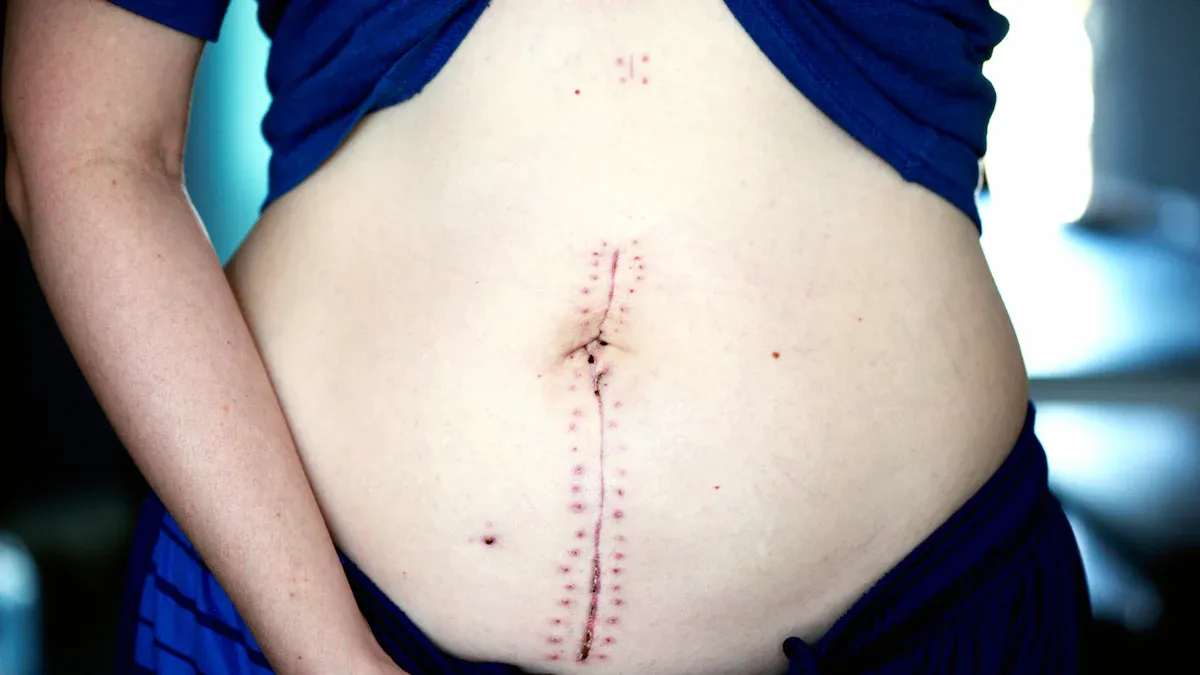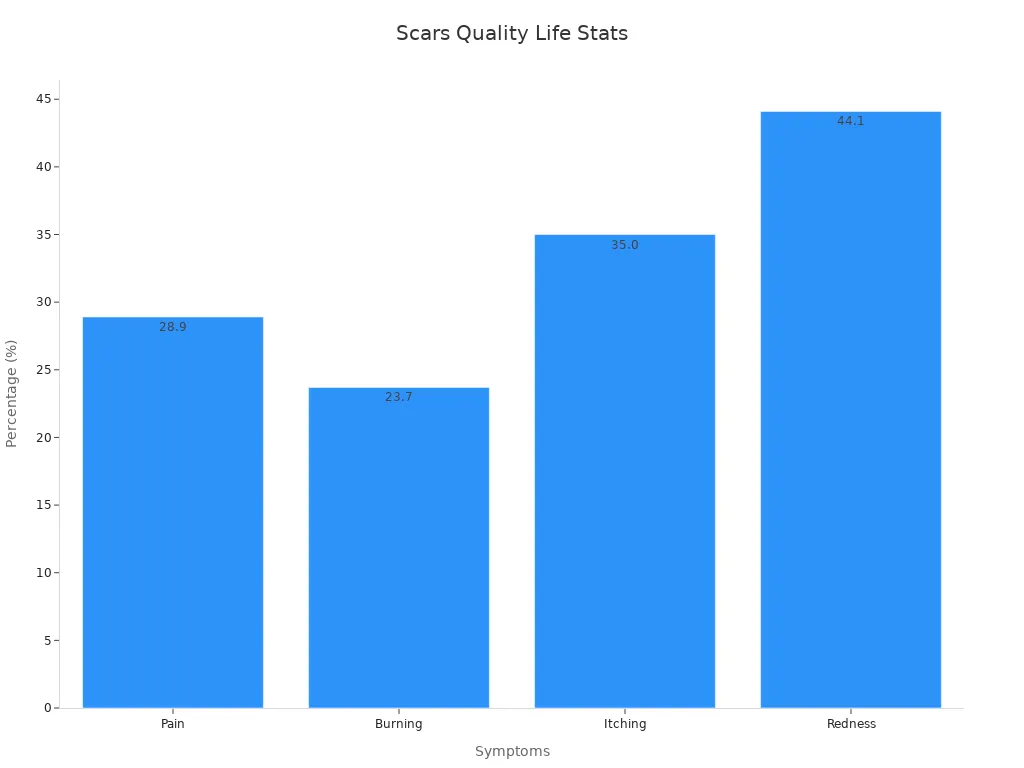How Scars Affect Your Skin and Mind

Scars change the skin’s texture and can deeply influence how a person feels about themselves. Many people with visible scars report feeling self-conscious, worried, or less attractive. Studies show that 51.8% feel unattractive and 43.2% believe scars harm relationships. The chart below highlights how scars affect emotional well-being.
Healing involves more than just the skin. Scar Management: Healing Your Skin must address both physical changes and emotional recovery for real progress.
Psychological and Social Impact Metric | Percentage of Participants |
|---|---|
Felt less attractive due to scars | 25.7% |
Felt embarrassed or self-conscious | 27.5% |
Avoided public appearances | 35.5% |
Felt scars negatively impacted relationships | 43.2% |
Felt unattractive due to scars | 51.8% |
Key Takeaways
Scars change the skin’s look and feel, often causing pain, itching, and tightness that affect daily life.
Visible scars can lower self-esteem and cause social challenges, but support and treatment can improve confidence.
Different types of scars need different treatments, including silicone gels, laser therapy, and sometimes surgery.
Healing scars requires care for both the skin and the mind, combining medical treatments with emotional support.
Building resilience through support groups, counseling, and self-acceptance helps people live well with scars.
Dual Impact
Skin Changes
Scars change the skin in many ways. They can make the skin look and feel different. Clinical studies show that scars from burns or injuries often have changes in color, thickness, and texture. Doctors use special tools like ultrasound and colorimeters to measure these changes. These devices check scar color, size, and how stretchy or dry the skin feels. Some scars, like hypertrophic scars and keloids, have too much collagen. In hypertrophic scars, collagen lines up in the wound area. In keloids, collagen grows outside the wound. Both types can cause itching, pain, and a rough look. Patients often say that pain and itching bother them more than how the scar looks. Treatments such as silicone gels, green tea, and onion extract can help with these symptoms. Electrical stimulation has also helped reduce pain and itching in some cases.
Note: Non-invasive devices give doctors a better way to track scar changes and see how treatments work over time.
Emotional Effects
Scars do not just change the skin. They also affect how people feel. Research shows that scars, especially on the face, can lower self-esteem and cause social problems. One clinical study found that people with facial acne scars felt better after treatment, both in how their skin looked and how they felt about themselves. The study showed a 31% improvement in scar appearance after four months. It also noted that scars can lead to stigma and make people feel left out. Teenagers with scars often feel embarrassed or avoid social events. Scars from diseases like cutaneous leishmaniasis can cause strong emotional pain, including sadness and anxiety. These effects show that scars impact both the body and the mind, making it important to care for both.
Skin Health

Types of Scars
Scars come in many forms, each with unique features and challenges.
Hypertrophic scars stay within the original wound area. They often appear raised and red. Doctors see these scars develop soon after an injury. Over time, they may flatten and fade.
Keloids grow beyond the wound’s borders. They can appear months or even years after the skin heals. Keloids often feel itchy or painful. People with darker skin tones, such as those of African, Asian, Hispanic, or Mediterranean descent, have a higher risk of developing keloids.
Mature scars look flat and pale. They usually cause fewer symptoms.
Immature scars appear red and may feel firm or itchy.
Scar contractures can limit movement, especially when they form over joints.
Doctors use special scales, like the Vancouver Scar Scale, to measure scar thickness, color, and texture. Treatments include massage, silicone gel sheets, and sometimes steroid injections. No single treatment works for everyone.
Scar types and their frequency can differ by age. The table below shows how scars affect children compared to adults and the elderly:
Aspect | Pediatric Scar Data | Comparison with Adults/Elderly |
|---|---|---|
Total pediatric scar cases | N/A | |
Prevalence in admitted children | 0.20% | Adults: 0.11%, Elderly: 0.02% |
Gender distribution | 62.27% males | Adults: 50.98%, Elderly: 49.85% |
Common injury cause | Scalds (37.10%) | N/A |
Common affected locations | Scalp/face/neck most common; higher proportions in upper limbs (27.88%), lower limbs (15.14%), perineum (4.59%) compared to adults/elderly | Adults upper limbs: 21.69%, lower limbs: 10.28%, perineum: 3.13% |
Scar types | Keloids 6.20% | Adults: 14.48%, Elderly: 18.15% |
Treatment | 66% received surgical treatment; lesion release most frequent operation (56.35%) | N/A |
Common complications | Scar contracture (45.27%) | N/A |
Median length of hospital stay | 9 days (range 5–15) | Slightly less in adults/elderly |
Appearance and Function
Scars do more than change how skin looks. They also affect how skin works. Scar tissue does not have the same structure as healthy skin. This can make the skin less flexible and more likely to feel tight or stiff. Some people notice pain, itching, or even trouble moving a joint if a scar forms nearby.
A study on breast surgery scars found that many patients felt pain and tightness. Some described their scars as a constant reminder of their surgery. These feelings can lead to sadness or even shame. Scars on the face or hands often cause the most distress because they are hard to hide.
Holistic care matters. Doctors recommend treating both the physical and emotional effects of scars. New treatments, such as laser therapy, help improve both appearance and function. Psychological support, like counseling, can also help people feel better about their scars.
Scars can also affect sleep and daily activities. Professional care helps people manage pain, itching, and movement problems. Addressing both the look and function of scars supports better health and well-being.
Mind and Emotions

Self-Esteem
Scars can shape how people see themselves. Many individuals with visible scars report changes in their self-esteem, especially when scars appear on the face or other noticeable areas. A documentary called "Scars: How Our Wounds Make Us Who We Are" showed that sharing personal stories about scars helped viewers feel better about their own bodies. People who watched the film said they felt more hopeful and confident. They also became more accepting of scars as part of their identity. The film helped reduce negative thoughts about people with scars and encouraged a broader view of beauty.
Research on teenagers with burn scars found that their overall self-esteem stayed close to normal. However, they felt less confident about their looks and athletic skills. Many of these teens cared a lot about appearance but felt unhappy with how they looked. This shows that scars can lower self-esteem in certain areas, even if a person feels okay in other parts of life.
Scars can become a source of strength and self-acceptance when people receive support and positive messages about their appearance.
Social Life
Scars often influence how people interact with others. Some scars tell a story about a person’s past, such as an illness or accident. These marks can shape how others see them and how they see themselves. In some cultures, scars even raise social status or show bravery. For example, ritual scarification can signal adulthood or courage.
The table below highlights how scars affect social interactions and relationships:
Aspect of Influence | Description | Example or Finding |
|---|---|---|
Communication of History and Personality | Scars show past trauma or illness and can reveal personality traits. | Scars may signal bravery or resilience. |
Attractiveness in Men for Short-term Relationships | Some facial scars in men can make them seem more attractive for short-term relationships. | Scars may suggest risk-taking or masculinity. |
Cultural Contexts and Social Status | Ritual scars can increase social standing in some societies. | Scarification marks rites of passage. |
Perceptions of Social Worth and Functionality | Scars can lower how others view a person’s social value, depending on location and cause. | Surgical scars may reduce perceived attractiveness. |
Historical and Social Symbolism | Scars have served as symbols of honor or bravery in history. | Fencing scars in 19th-century Germany were seen as marks of distinction. |
Not all scars have the same effect. Some people feel proud of their scars, while others feel embarrassed or left out. The location and cause of a scar can change how it affects social life. For example, scars on the face or hands are harder to hide and may lead to more questions or stares. In contrast, scars on less visible areas might cause less worry in social settings.
Mental Health
Scars can affect mental health in many ways. People with visible scars, especially on the face, have a higher risk of anxiety and depression. A large study followed over 179,000 people with facial scars. The results showed that those with facial scars had more cases of anxiety and depression than people without scars. The risk was even higher for women, younger people, and those with scars from violence. The study also found that these mental health challenges could last for years after the injury.
Aspect | Scarred Patients | Controls |
|---|---|---|
Incidence of Anxiety (per 1000 person-years) | 7.48 | |
Incidence of Depression (per 1000 person-years) | 16.28 | 9.56 |
Doctors noticed that the way a person feels about their appearance matters more than the actual size or severity of the scar. People who worry a lot about how they look tend to feel more distress, even if their scar is small. Some research suggests that scars on the trunk or legs can cause just as much concern as facial scars, depending on how the person feels about their body.
Mental health support is important for anyone with visible scars. Early counseling and support groups can help people cope with feelings of sadness, worry, or isolation.
Scars can lead to social withdrawal, low self-esteem, and long-term emotional pain. Addressing both the physical and emotional sides of scarring helps people heal more fully and regain confidence in daily life.
Skin and Identity
Confidence
Scars can shape how people feel about themselves. Many individuals with facial scars experience emotional reactions that lower self-confidence. These feelings often come from changes in self-worth and how they see their own appearance. Society places a high value on flawless skin, which increases self-awareness and can make people with visible scars feel less confident. Social interactions may become stressful because of worries about being judged. Friendships, romantic relationships, and even social events can feel more challenging.
Facial scars often trigger emotional responses that affect self-worth.
Society’s focus on perfect skin increases self-consciousness.
People may worry about how others judge them, which can impact friendships and relationships.
In the workplace, visible scars sometimes lead to bias, affecting how others see competence and trust.
Some cultures view scars as symbols of strength, which can boost confidence, while others may stigmatize scars.
Support groups and counseling help people manage these feelings and build self-acceptance.
Medical and cosmetic treatments give people options to improve scar appearance and regain confidence.
People often find that support from others and access to treatment options help them feel more in control of their self-image.
Daily Life
Scars can affect many parts of daily living. People often think about their scars and talk about them with others. Some feel discomfort when changing clothes or during intimate moments. Physical symptoms like itching, pain, or tightness can limit movement and make daily tasks harder. Scar color, size, and location also influence how noticeable a scar is and how a person feels about it.
Statistic/Measure | Value/Description |
|---|---|
Survey sample size | |
Respondents with scars <1 year | 48.5% |
Reported symptoms in recent scars | Pain: 28.9%, Burning: 23.7%, Itching: 35.0%, Redness: 44.1% |
Average Dermatology Life Quality Index (DLQI) score for recent scars | 7.44 (moderate impact) |
Average DLQI score after 1 year | 2.90 (reduced impact) |
QoL impact frequency for scars <3 months | 33.9% |
QoL impact frequency for scars ≥12 months | 10.2% |
Daily life aspects significantly impacted by skin discomfort or scar visibility | Body movement, clothing choices, leisure activities, sexual life, embarrassment |

People with scars often change their clothing choices or avoid certain activities. Some feel embarrassed or less satisfied with their appearance, but many grow to accept their scars over time. Support from friends, family, and professionals can help individuals adapt and improve their quality of life.
Scar Management: Healing Your Skin
Medical Options
Doctors use many medical treatments to help people with scars. Scar Management: Healing Your Skin often starts with non-surgical options. Silicone sheets, gels, and steroid injections can reduce scar size and symptoms. Some patients need surgery if scars limit movement or cause pain. Surgery works best for scars that affect how the body moves, but keloids often return without extra care.
Laser therapy has become a popular choice in Scar Management: Healing Your Skin. Clinical trials show that early use of non-ablative fractional lasers can improve scar formation after injury. Fractional laser therapy helps traumatic scars and has a low risk of problems. Ablative fractional lasers also make it easier for medicines to reach the scar, which improves results. Doctors often use lasers soon after stitches come out to prevent bad scarring.
The table below shows results from a meta-analysis of laser treatments for scars:
Parameter | Result / Finding |
|---|---|
Number of clinical trials | 28 |
Number of patients | 919 |
Overall response rate (laser) | 68-72% (hypertrophic scars and keloids) |
Best laser types | 585/595-nm pulsed-dye laser, 532-nm laser |
Effects on hypertrophic scars | Reduced scar height, erythema, and Vancouver Scar Scale scores |
Optimal treatment interval | 5 to 6 weeks |
Safety and efficacy | Confirmed for hypertrophic scars; low evidence for keloids |
Doctors choose the best treatment based on scar type, location, and patient needs. Scar Management: Healing Your Skin works best when doctors use a mix of treatments and monitor progress over time.
Emotional Support
Scars can affect how people feel about themselves. Scar Management: Healing Your Skin must include care for the mind as well as the body. Research shows that stress can make scars worse, especially keloids. Psychological therapies such as cognitive-behavioral therapy, acceptance and commitment therapy, and narrative therapy help people manage anxiety and sadness. These therapies improve mental health and help people cope with changes in appearance.
Support groups give people a place to share their stories. Burn survivors and others with scars often find hope and comfort in talking with others who understand. Family support programs help by teaching families how to support loved ones and handle social challenges. Scar Management: Healing Your Skin improves when patients have access to both medical and psychological care.
Doctors now use integrated care models. These models combine skin treatments with therapy and education. Patients who receive both types of care report less anxiety, depression, and social avoidance. Multidisciplinary teams work together to plan treatment and check progress. This approach helps people feel better inside and out.
Building Resilience
Healing from scars takes time and support. Scar Management: Healing Your Skin should focus on building resilience. Resilience means the ability to recover from setbacks and adapt to changes. People with scars often face challenges in daily life, but many learn to accept their scars and grow stronger.
A comprehensive review highlights the need for a plan that treats both physical and emotional issues. Doctors use tools like the PRISM scale to measure how scars affect self-esteem and quality of life. These tools help doctors understand what matters most to each patient. Scar Management: Healing Your Skin works best when doctors listen to patients and adjust care as scars change.
Tips for building resilience include:
Joining support groups or talking with others who have scars
Practicing self-acceptance and focusing on strengths
Setting small goals for recovery and celebrating progress
Seeking help from counselors or therapists when needed
Note: Healing is a journey. Scar Management: Healing Your Skin should support both the body and the mind for the best results.
Scar Management: Healing Your Skin is not just about changing how scars look. It is about helping people feel whole again. By combining medical treatments with emotional support, patients can regain confidence and improve their quality of life.
Caring for scars means looking after both the skin and the mind. Many effective treatments and support systems exist for physical and emotional healing. Studies show that:
Relaxation techniques help reduce stress and support skin recovery.
Manual therapies may ease pain and itching.
People can seek help, practice self-compassion, and find hope. Healing grows stronger with support and resilience.
FAQ
What causes scars to form on the skin?
Scars form when the skin heals after an injury. The body produces extra collagen to repair the wound. This new tissue looks and feels different from normal skin.
Can scars fade over time?
Many scars become less noticeable as time passes. Some scars flatten and lighten in color. Treatments like silicone gels or laser therapy can help speed up this process.
Do scars always hurt or itch?
Not all scars cause pain or itching. Some people feel discomfort, especially with new or raised scars. Others may not notice any symptoms. Doctors can suggest ways to manage these feelings.
How do scars affect mental health?
Scars can impact self-esteem and mood. Some people feel anxious or sad about their appearance. Support from family, friends, or counselors helps many people cope with these feelings.
Are there ways to prevent scars from getting worse?
Yes. Keeping wounds clean and covered helps healing. Using sunscreen on scars prevents darkening. Doctors may recommend special creams or treatments to reduce scar growth.
See Also
Recognizing Symptoms And Treatment Options For Conjunctival Melanoma
A Comprehensive Guide To Keratoacanthoma And Its Characteristics
Identifying Symptoms And Causes Of Basal Cell Carcinoma
